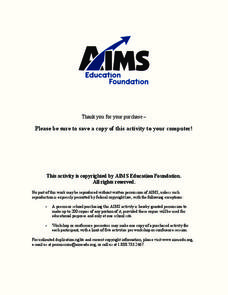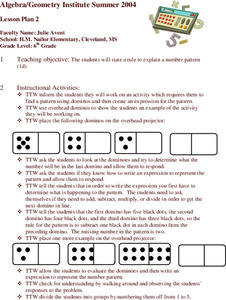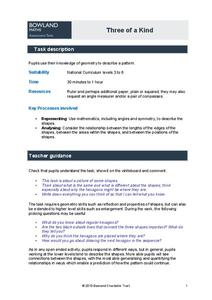Curated OER
Get Your Numbers in Shape - TI-83
High Schoolers use the TI-83 calculator to produce a sequence, explore patterns and find a linear or quadratic equation for a given pattern. They use inductive reasoning to make conjectures about patterns. They find the Y-value of a...
Curated OER
Counting Chart
Elementary learners discover counting through a counting chart. In this math lesson plan, students identify numbers 1-100. They then point or recite their counting numbers.
Curated OER
Measure
Students are asked what activities or things that they do each day. They are then asked do you do that in the morning, afternoon, or night? Students are then asked which of those things do you do first, second, third, and etc.
Curated OER
Bears Wear Buttons
Students practice counting sets of objects and numerals. In this numerical identification lesson, students listen to the story, Bears Wears Buttons, and participate in a flash card activity where students must place buttons on a card...
Curated OER
Number Patterns
Sixth graders study number patterns. They observe dominoes to determine the next domino in the sequence. After studying the dominoes, they write an expression to represent the pattern.
Curated OER
Rooster's Night Out
Mitch Weiss and Martha Hamilton's Rooster's Night Out, a retelling of a classic Cuba folktale, launches a cross-curricular study of Cuban cultural traditions. Class members draw the characters from the book, participate in math and...
Curated OER
Number Sequence Rules
In this number sequence interactive worksheet, students fill in the missing numbers in each of the 14 number sequences. There are three numbers missing in each number sequence.
Curated OER
Advanced Algebra with the TI-89
Pupils investigate the formulas for volumes of various solids using the Ti-89 calculator. The lesson focuses on the keying sequences necessary to embed the required volume formula in a program which is then used in the problem solving...
Curated OER
Comprehension Through The Very Hungry Caterpillar
Students sequence seven events from "The Very Hungry Caterpillar" by matching the correct event with the day of the week. They recall details from the story as they unscramble words on a worksheet.
Curated OER
Spatial Relationships: an Over/Under Dance
Students explore the relationships of space through movement. Two perform movement improvisation based on over/under. The activity improves hand-eye coordination, cooperation, and communication skills. The timing of the dance also...
Core Knowledge Foundation
A “Whole” Lot of Fraction Fun!
Young mathematicians are introduced to fractions in a unit that helps them to understand parts of a whole.
Sprite Box
Lightbot Jr 4 Coding Puzzles
Learning how to write computer code has never been so much fun! Given control of their very own robots, children create simple programs in order to solve a series of challenges and develop their problem solving skills.
Mathematics Vision Project
Quadratic Functions
Inquiry-based learning and investigations form the basis of a deep understanding of quadratic functions in a very thorough unit plan. Learners develop recursive and closed methods for representing real-life situations, then apply these...
EngageNY
Algebraic Expressions—The Distributive Property
Do your classes truly understand the distributive property? Use a demonstrative lesson to represent the distributive property in various ways. Learners solidify understanding by creating a geometric pattern for distributive property, and...
EngageNY
Equivalent Rational Expressions
Rational expressions are just fancy fractions! Pupils apply fractions concepts to rational expressions. They find equivalent expressions by simplifying rational expressions using factoring. They include limits to the domain of the...
EngageNY
Euler’s Number, e
Scholars model the height of water in a container with an exponential function and apply average rates of change to this function. The main attraction of the instructional activity is the discovery of Euler's number.
Bowland
Three of a Kind
One is chance, two is a coincidence, three's a pattern. Scholars must determine similarities and differences of a regular hexagon undergoing dilation. They look at lengths, angles, areas, and symmetry.
EngageNY
Analyzing Decisions and Strategies Using Probability 1
Learn how to increase the probability of success. The 19th installment of a 21-part module teaches future mathematicians how to use probability to analyze decisions. They determine strategies to maximize the chances of a desired outcome.
Curated OER
Triangle Series
Your algebra learners emphasize the"geometric" in geometric series as they use a common ratio between algebraic terms and find that it corresponds to a repeated similarity transformation.
Illustrative Mathematics
Similar Circles
Young geometers flex their transformation muscles in this brief but powerful exercise using dilations and translations to develop the similarity of circles. The plan provides guidelines to help learners navigate a pair of deceptively...
Illustrative Mathematics
Why Does SSS Work?
While it may seem incredibly obvious to the geometry student that congruent sides make congruent triangles, the proving of this by definition actually takes a bit of work. This exercise steps the class through this kind of proof by...
Mathematics Vision Project
Module 2: Congruence, Construction and Proof
Construct yourself a winning geometry unit. A set of lessons introduces geometry scholars to constructions and proofs with compasses and straightedges. It also covers triangle congruence through transformations. This is the second of...
Curated OER
Mixed Fraction Sequences
In this math learning exercise, students complete the mixed fractions that are sorted into a sequence. The sheet is intended as a teacher's guide.
Curated OER
Decimal Sequences
In this math worksheet, students solve the problems that are intended to focus upon he sequences of decimals. The sheet is a teacher's guide.
























